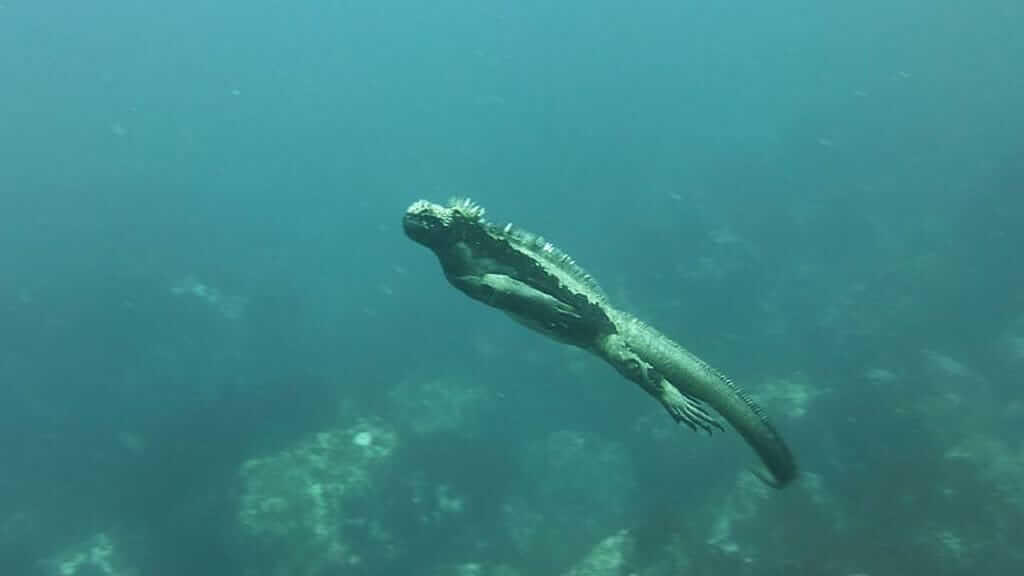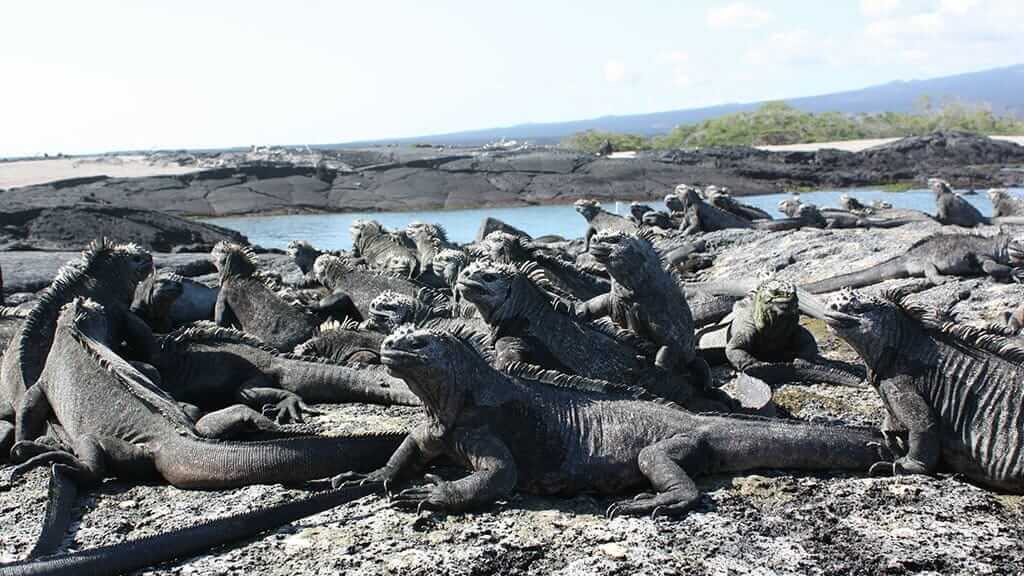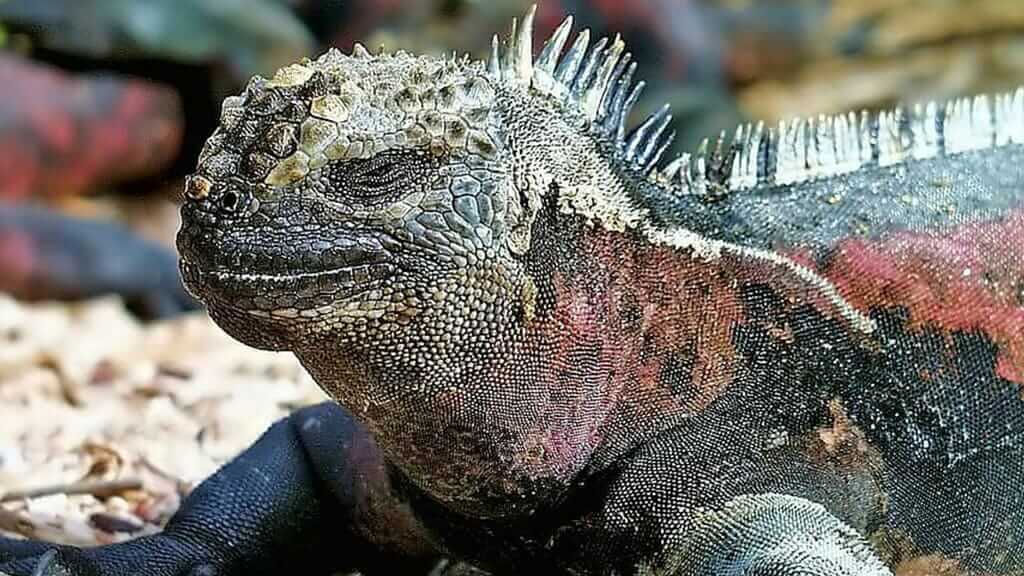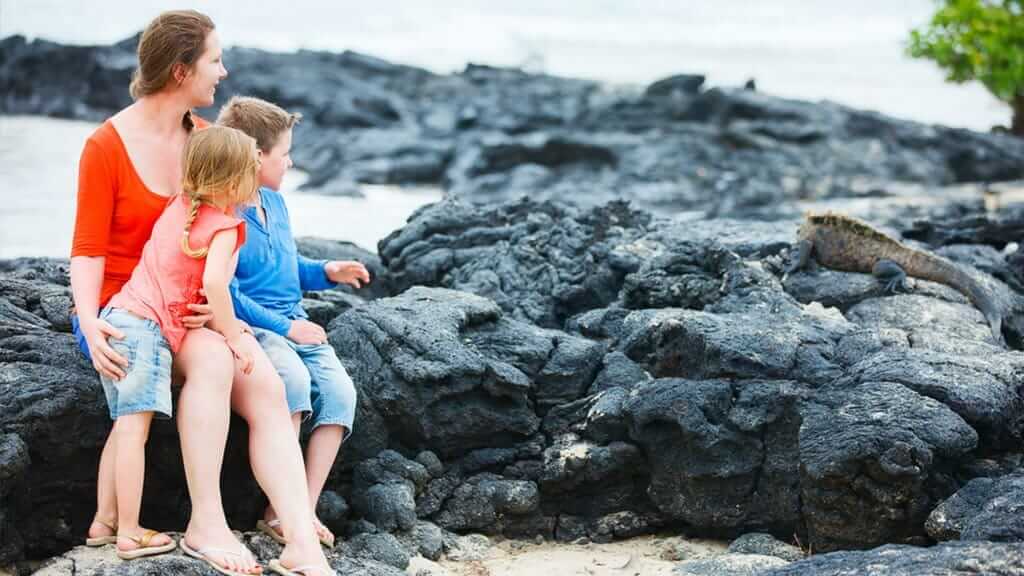MARINE IGUANA GALAPAGOS ISLANDS
The Galapagos Marine Iguana is one of the more curious creatures encountered on the Galapagos Islands. An endemic to Galapagos, they have a fascinating tale of evolution and survival to share. Not only is the marine iguana the only lizard in the world to have learned how to swim & dive, but it can also physically shrink in size when times are tough. Visitors can spot marine iguanas of contrasting colors and sizes on different Galapagos islands. More often than not they are huddled together, sneezing salt from their nostrils. Curious creatures indeed!
The Marine Iguana is a common sight in the Galapagos, and very popular with tourists. So, let's get to know the Galapagos marine iguana a little better.
Read on for everything you need to know about marine iguanas. Where and when can you see them at Galapagos? What unique evolutionary adaptations have they made? Plus lots more interesting marine iguana facts.
SECURE YOUR GALAPAGOS TRAVEL
Get a FREE personalised quote todayThe Marine Iguana is a Galapagos ENDEMIC SPECIES.
Conservation Status: Vulnerable
Marine Iguana Scientific Name: Amblyrhynchus Cristatus
How To See A Marine Iguana At Galapagos?
The Galapagos Islands is the only place in the world where you can see Marine Iguanas. They are a common sighting right across the archipelago, spotted in large colonies on land, or with luck underwater when snorkeling. It's easy to spot marine iguanas aboard a Galapagos Cruise or a Land Tour.
These amazing reptiles are popular with tourists for their tame nature and Godzilla-like appearance. But not all visitors have been impressed. Famous botanist Chares Darwin referred to marine iguanas as: “most disgusting, clumsy lizards”, and “Imps of darkness” during his 1835 voyage on the HMS Beagle. Opinions may be divided, but few can fail to be impressed by their unique evolutionary adaptations.
WHERE to see Marine Iguanas in Galapagos?
Galapagos marine iguanas live right throughout the archipelago. Cruise visitors can cross paths with large Marine Iguana colonies on Fernandina, Española, Santa Cruz, and Isabela Islands. On land trips, look out for marine iguanas at Tortuga Bay Beach (Santa Cruz) and Puerto Villamil Beach (Isabela).
Galapagos marine iguana typical habitat is on sandy shorelines close to black lava rocks. They need sandy terrain to dig their burrows, while the black lava provides camouflage & protection during the day. Of course, they also need to be close to the ocean to dive for food.
WHEN to see a Galapagos Marine Iguana?
Marine iguanas can be spotted all year round, they are permanent residents of the Galapagos Islands and are always active. Marine Iguana mating season runs typically from January to March, with baby marine iguana hatchlings emerging around 3 months later.
Contact us for a FREE GALAPAGOS TOUR QUOTE, or for more information to plan your Galapagos Islands vacation.
GET FREE ADVICE
From a Galapagos destination expert todayEverything You Need To Know About Galapagos Marine Iguanas
Marine Iguana Characteristics
In appearance, marine iguanas look like large lizards. They have long tails, a spikey dorsal fin, a heavily scaled face, and strong clawed feet.
Marine iguanas are most easily differentiated from their Land Iguana cousins by color. While Land Iguanas are yellow, Marine Iguanas are a shade of black or grey. This is necessary for these cold-blooded reptiles to absorb the sun and maintain warmth. Colors do vary between different marine iguana subspecies on each island (see facts section below).
Marine Iguana Size
Male marine iguanas can typically grow to a length of up to 4-5 feet, weighing up to 3.3 pounds. Females are often just half the size of their male counterparts.
Marine iguanas are also smaller than land iguanas.
Marine Iguana Lifespan
The average Galapagos marine iguana lives for up to 12 years, while the oldest recorded marine iguana age is close to 60.
Marine Iguana Adaptations
The Galapagos Marine Iguana is originally descended from a South American mainland Iguana species.
How did South American iguanas arrive on remote islands in the Pacific Ocean? Most likely they were accidentally swept into rivers, out into the sea, and drifted on logs or foliage with ocean currents to the Galapagos.
The volcanic habitat of the Galapagos is harsh indeed, so the iguana arrivals needed to adapt and evolve in order to survive here.
The main priority at first of course was food. On some islands, the iguanas got lucky in finding tasty vegetation to eat. On other islands though the land was barren, with the only green food source found in the sea. So they had to learn to swim and dive in order to eat, eventually evolving into the Galapagos marine iguana species we find today.
Various Marine Iguana adaptations were necessary to make this leap into the water. Their respiratory system transformed to allow deep diving. They evolved a special blood pigment that holds more oxygen, essential for long dives. Marine iguana teeth became sharper to cut away algae and seaweed from the rocks. Long claws developed to grip slippery rocks underwater. The Marine iguana tail became streamlined to steer expertly when swimming. A flatter snout gave easier access to food on the rocks. Their unique nostril glands allow them to desalinate after swimming (spitting salt from their noses). Their skin also turned darker for better sun heat absorption to keep them warm in the cold Galapagos waters. All in all, it was quite a remarkable transformation from land iguana to marine iguana species!
So why did the land iguanas that we see today at Galapagos not evolve in the same way? Land Iguanas descended from a second wave of mainland iguana arrivals a long time afterward. So perhaps they have not had enough time to adapt to the same extent. Also, land plants had begun to colonize the islands by that time, so cacti and other plants provided more convenient food for them.
Marine Iguana Reproduction & Common Behavior
Marine Iguanas live together in large colonies. Visitors can often observe them in large groups lying one on top of another in photogenic poses. This behavior is very important to maintain body temperature. Every morning marine iguanas sunbathe together in this fashion until their body temperature is high enough to enter the cold water to feed.
Now it's time for food! Marine iguanas dive searching for algae on volcanic rocks. Their strong claws grip to the slippery surface, while sharp teeth pull off food. Emerging from the water they'll group up again to increase body temperature as quickly as possible.
Galapagos marine iguana mating season begins in January. At this time it is common to see males battling over turf, charging each other, and "locking horns". Every male wants to control his own harem of females, and size it turns out is important after all. Females often select larger males in the hope that their genes will be passed down to their offspring. Each female marine iguana lays 2 or 3 eggs, which she buries in a burrow, her job is now over.
Marine iguana baby hatchlings emerge 3-4 months later and are on their own from the off. Baby marine iguanas have a long list of terrifying predators, from Galapagos hawks to racer snakes. Generally speaking, larger babies have a higher probability of survival. The reward for marine iguanas that do reach adulthood is that they no longer need to worry about getting eaten on land.
One final noteworthy marine iguana behavioral trait is that they are extremely tame. They have no fear of humans whatsoever. Charles Darwin noted back in 1835; that if he threw a marine iguana into the water, it would return to land at the exact same place again. Tourists love this about Galapagos marine iguanas as it makes closeup photography a breeze.
Marine iguana diet
What do Galapagos marine iguanas eat? They are herbivores, feeding on a diet of green algae and seaweed. They usually dive for up to one minute at a time, with their heartbeat slowing to half its normal rate to conserve energy in the cold water. They cut algae from the rocks using their strong marine iguana teeth.
Why is the Galapagos Marine Iguana Endangered?
Today the marine iguana population in the Galapagos islands numbers between 200,000 to 300,000 individuals. They are listed as Vulnerable and in decline by the IUCN Red List. But why is this?
Marine Iguana Predators
Firstly, there is a long list of marine iguana predators. Hawks and snakes in particular hunt baby marine iguanas in large numbers during hatching season. Given that marine iguana hatchlings do not receive protection from their parents they are often easy prey. Invasive species like rats, cats, and dogs are also a big threat on some islands, feeding on marine iguana eggs and young.
Fortunately, Galapagos conservation projects are ongoing to eradicate introduced invasive species and return marine iguana habitats back to their original state.
El Niño
The El Niño weather phenomenon is another big risk for Galapagos marine iguanas. El niño occurs every decade or so, affecting the whole coast of South America. It causes a small rise in sea temperatures, which in turn reduces the important nutrients found in the ocean. Fewer algae and plankton means hungry marine iguanas. Severe El Niño events mean that no hatchlings survive, and also causes a huge dent in adult population numbers (70% loss in El Niño 1982/3). It takes many years afterward for marine iguana colonies to recover.
Interesting Marine Iguana Facts
• A Marine Iguana sneezing salt is a peculiar sight in Galapagos. After swimming in the sea they need to expel sea salt from their bodies. So marine iguanas have special glands in their nose enabling them to filter out salt and sneeze it out. Visitors can often see an accumulation of salt on top of their heads, encrusted in white as a result.
• There are a total of eleven different Marine Iguana subspecies in the Galapagos. The largest marine iguanas in size live on San Cristobal island, measuring over one meter in length. Rather appropriately they have been named the Godzilla Marine Iguana (Amblyrhynchus Cristatus Godzilla).
• Galapagos marine iguanas also vary in color between each island subspecies. The most colorful are the Christmas iguanas on Española Island, in wonderful bright red and green combinations. Genovesa has the smallest and blackest marine iguana population. Fernandina and Northern Isabela have marine iguanas colored dull green and red. On Santa Cruz, they are red and black. Marine iguana coloring can also change through the seasons, becoming brighter during mating season, before returning to regular black.
• In times of scarce food the Galapagos Marine Iguana has developed an ability that almost no other animal can do: it shrinks! Quite literally, bones become smaller and their skeleton retracts. This means that they can eat less without becoming malnourished. As soon as food sources return to normal levels they then grow back to their original size again.
Check out our separate posts for more interesting Marine Iguana facts or to learn about more Galapagos Reptiles & Animals.
Book With The #1 Trusted
Galapagos Travel Agency
In conclusion, the Galapagos marine iguana is one of the most fascinating characters on the Galapagos islands. They are hugely photogenic for visitors when they huddle together in groups. They have an incredible story to tell, of evolution and adaptation against all the odds. They demonstrate unique and quirky behavior. Plus you never get tired of spotting them because they come in different colors and sizes on each island. We hope you enjoyed learning about the Galapagos marine iguana, now it's time to go meet them for yourself!





